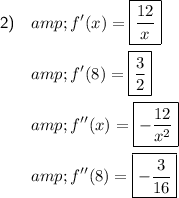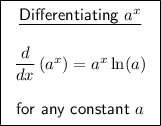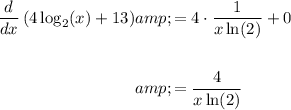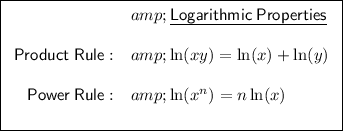Answer:




Explanation:
Question 1
To find the derivative of 3^x we can use the following rule:

Therefore:


Question 2
To differentiate f(x) = 12 ln(x), we can use the differentiation rule for ln(x):

First, take the constant out:

Now, apply the derivative rule:

Therefore:

To find f'(8), simply substitute x = 8 into f'(x):

To find the second derivative f''(x), we can differentiate f'(x).
Begin by rewriting the denominator of f'(x) using the negative exponent rule:

Now, use the power rule for differentiation:

Therefore:



To find f''(8), substitute x = 8 into f''(x):


Question 3
To differentiate 4log₂(x) + 13, we can use the derivative log rule and the the constant rule:

Therefore:


Question 4
Given:
![f(x)=\ln \left[x^9(x+3)^5(x^2+5)^7\right]](https://img.qammunity.org/2024/formulas/mathematics/college/jb919noeglrras8oy6gsf0x86iuv47sj31.png)
Before taking the derivative of f(x), we can expand the function using the Properties of Logarithms.

First, apply the product rule:

Then, apply the power rule:

Now we can differentiate f(x) using the following rule:

Therefore:
![\begin{aligned}(d)/(dx)\left[9\ln (x)+5\ln (x+3)+7\ln (x^2+5)\right]&=9 \cdot (1)/(x)+5 \cdot (1)/(x+3)+7 \cdot (2x)/(x^2+5)\\\\&=(9)/(x)+(5)/(x+3)+(14x)/(x^2+5)\end{aligned}](https://img.qammunity.org/2024/formulas/mathematics/college/huweohsjs75cgaaica5bfbv1pk9sl6becf.png)